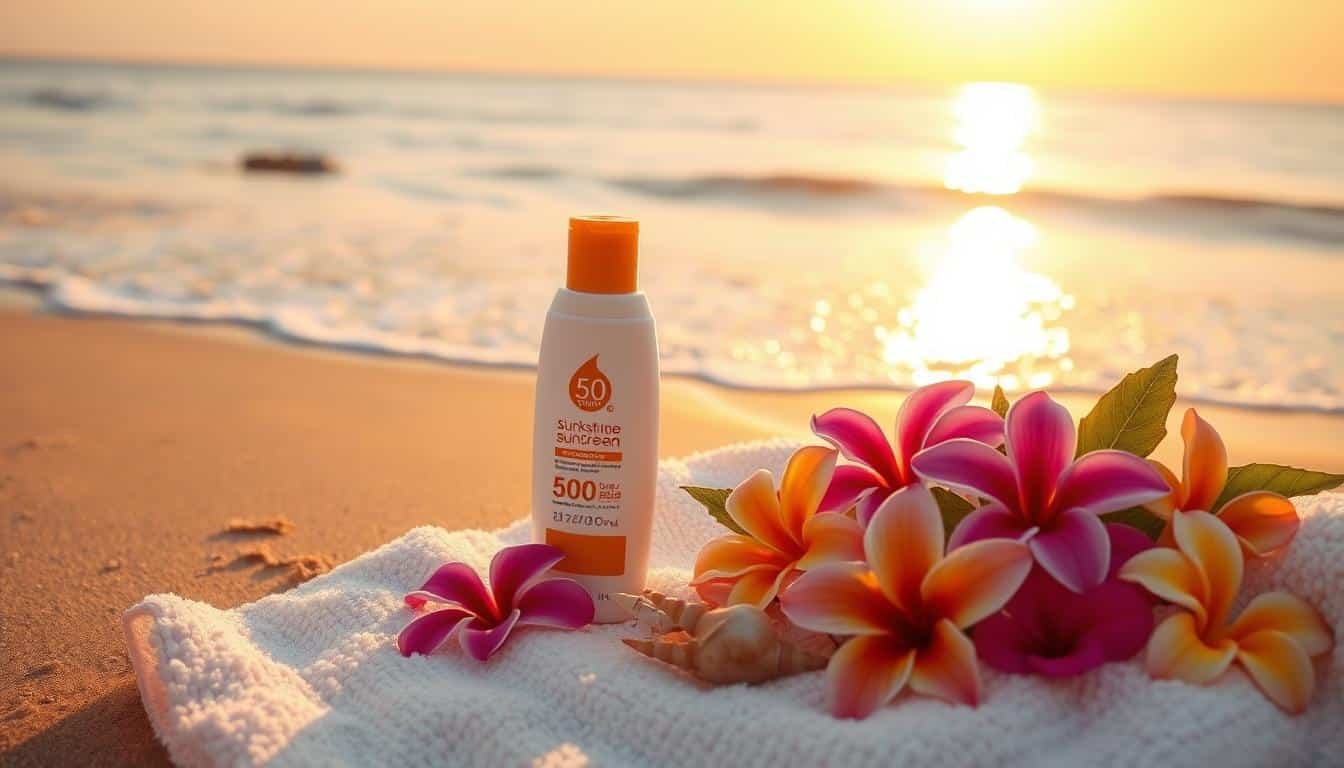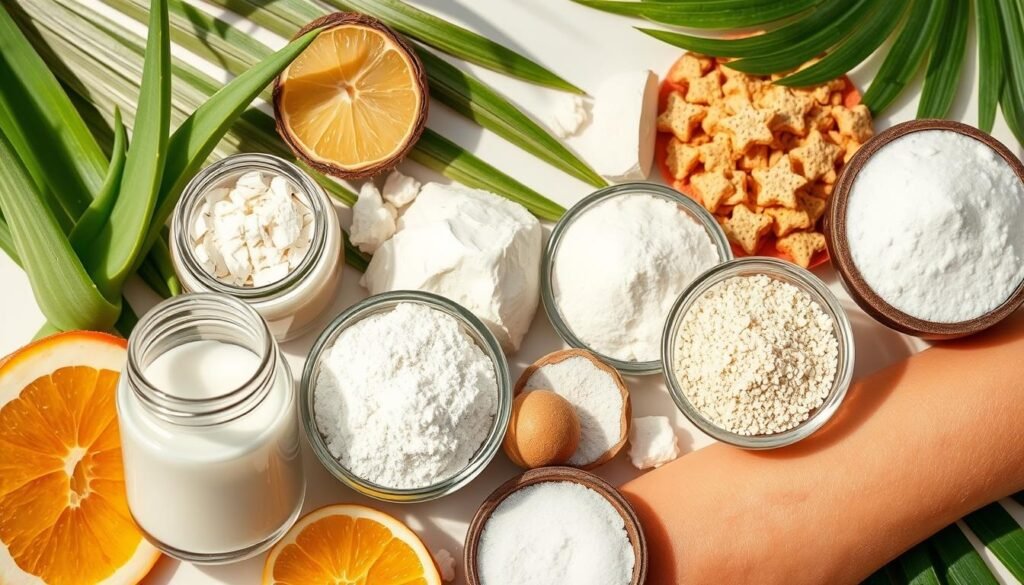Keeping your skin healthy and young is important to many. Sunscreen is key in protecting it from harmful UV rays. These rays can cause early aging, wrinkles, and skin cancer, including deadly melanoma.
Studies show that using sunscreen often has big benefits. It can cut the risk of skin cancer by a lot. For example, it reduces squamous cell carcinoma by 40% and melanoma by 50%. Also, it slows down signs of aging, keeping your skin smooth and bright for longer.
Key Takeaways : Skin Protection
- Sunscreen is vital for shielding skin from UV damage, preventing early aging, wrinkles, and skin cancer.
- Using sunscreen regularly can greatly lower skin cancer risk, by 40% for squamous cell carcinoma and 50% for melanoma.
- It also delays aging signs like fine lines, age spots, and crepey skin, keeping skin looking young.
- Choosing a broad-spectrum sunscreen with SPF 30 or higher is crucial for full skin protection.
- Applying sunscreen correctly and often is essential for the best protection and healthy skin.
The Importance of Sunscreen for Skin Cancer Prevention
Skin cancer is a big worry, with over 5 million new cases in the U.S. each year. The most common types are basal cell carcinoma (BCC) and squamous cell carcinoma (SCC). Melanoma is the deadliest type. Studies show that UV radiation from the sun is the main cause of skin cancer.
Studies Show Regular Sunscreen Use Can Lower Cancer Risk
Good news is that using sunscreen often can cut down skin cancer risk. A study found daily sunscreen use can lower squamous cell carcinoma risk by 40%. It can also cut melanoma risk by 50%. Using sunscreen regularly is key to preventing skin cancer.
To keep your skin safe and lower skin cancer risk, make sunscreen a daily habit. Adding sunscreen to your daily routine helps keep your skin healthy and young. It also lowers your risk of a deadly disease.
“Daily sunscreen use can lower the risk of squamous cell carcinoma by 40% and melanoma by 50%.”
Understanding UVA and UVB Rays

Ultraviolet (UV) radiation is key to many skin issues, like aging and skin cancer. It’s vital to know the differences between UVA and UVB rays to protect our skin.
UVA rays cause skin aging and some skin cancers, like melanoma. They go deep into the skin, harming collagen and elastin. This makes our skin look old. UVA rays are always a threat, even through windows and clouds.
On the other hand, UVB rays lead to sunburns. They don’t go as deep as UVA but hit the skin’s surface hard. This causes redness, swelling, and raises skin cancer risk.
Both UVA and UVB rays are bad and can lead to skin cancer. That’s why using a broad-spectrum sunscreen is key. It protects against both types of UV radiation.
“UVA rays may not cause immediate sunburn, but they can penetrate deep into the skin, leading to long-term damage and premature aging.”
- UVA rays cause premature aging and some skin cancers
- UVB rays lead to sunburns and help cause skin cancer
- Using broad-spectrum sunscreen protects against both UVA and UVB rays
Skin Protection for All Skin Tones

Skin cancer can happen to anyone, no matter their skin color. People with fair skin are more at risk because they have less melanin. But, those with darker skin tones can also get skin cancer.
Some groups like African Americans and Hispanics often find skin cancer in more severe stages. This makes their outcomes worse. So, everyone needs to protect their skin from the sun, no matter their skin color.
Using broad-spectrum sunscreen is key for all skin types. It helps prevent skin cancer and damage from the sun. Adding sunscreen to your daily routine can keep your skin smooth and healthy-looking.
| Skin Tone | Skin Cancer Risk | Importance of Sunscreen |
|---|---|---|
| Fair Skin | Higher risk due to lower melanin content | Essential for protection against UV radiation |
| Darker Skin | Also at risk, often diagnosed at advanced stages | Crucial for preventing skin cancer and maintaining healthy skin |
Choosing a sunscreen that protects against UVA and UVB rays is vital for all skin tones. By focusing on sun protection, you can reduce your skin cancer risk. This way, you can keep your skin looking young and healthy for a long time.
Choosing the Right Sunscreen Ingredients

Finding the best sunscreen can be tough with so many options. It’s key to pick one with the right active ingredients for full skin protection. Mineral sunscreens like those with zinc oxide or titanium dioxide are safer and more effective than chemical sunscreens.
Mineral sunscreens protect against both UVA and UVB rays. Look for avobenzone to block UVA rays and octocrylene for UVB protection. Avoid oxybenzone and octinoxate as they can harm the environment and human hormones.
If you’re worried about the ocean, choose “reef-safe” sunscreens without harmful ingredients. Pick a sunscreen with the right SPF and broad-spectrum coverage for best protection and peace of mind.
Safe and Effective Ingredients
For a safe and effective sunscreen, look for these ingredients:
- Zinc oxide – a mineral that protects against UVA and UVB rays
- Titanium dioxide – a mineral that also protects against UVA and UVB rays
- Avobenzone – a chemical that blocks UVA rays
- Octocrylene – a chemical that stabilizes avobenzone and protects against UVB rays
Avoid sunscreens with oxybenzone and octinoxate as they’re bad for the environment and human hormones.
| Ingredient | Type | Benefit |
|---|---|---|
| Zinc Oxide | Mineral | Broad-spectrum protection against UVA and UVB rays |
| Titanium Dioxide | Mineral | Broad-spectrum protection against UVA and UVB rays |
| Avobenzone | Chemical | Effective UVA protection |
| Octocrylene | Chemical | Stabilizes avobenzone and provides UVB protection |
| Oxybenzone | Chemical | Potential hormonal disruptions and environmental concerns |
| Octinoxate | Chemical | Potential hormonal disruptions and environmental concerns |
Proper Application and Reapplication

Applying and reapplying sunscreen right is key to protecting your skin from the sun. Put it on about 20 minutes before you go outside. This lets the sunscreen work best to shield your skin.
When you put sunscreen on, use a lot and make sure your skin is fully covered. You need to reapply sunscreen too, especially if you’re active, sweating, or in the water. The American Academy of Dermatology says to reapply every two hours or more if you’re swimming or sweating.
Choosing a water-resistant sunscreen helps keep you protected during activities. Making sure to apply and reapply sunscreen correctly is crucial. It helps prevent sunburn, early aging, and skin cancer.
| Sunscreen Application Recommendations | Sunscreen Reapplication Recommendations |
|---|---|
| Apply about 20 minutes before sun exposure | Reapply every 2 hours or more frequently if swimming or sweating |
| Use a liberal amount to ensure full coverage | Use a water-resistant sunscreen to maintain protection |
“Proper sunscreen application and reapplication are essential for ensuring comprehensive skin protection against the sun’s harmful rays sun’s uv rays it’s also important even when you’re.”
Also Read : How Can A Healthy Diet Help Reduce Skin Problems?
Conclusion
Keeping the skin safe from ultraviolet radiation is key to good skin health and lowering skin cancer risk. Sunscreen is a crucial shield against UVA and UVB rays even when you’re.
Choosing the right sunscreen and applying it right helps protect the skin. It cuts down the risk of skin cancer, including deadly melanoma. It also slows down skin aging, keeping skin looking young and healthy.
Adding sunscreen to your daily routine is an easy yet effective way to care for your skin. Regular use of sunscreen prevents skin cancer and aging. This lets people enjoy the sun safely, keeping their skin healthy and vibrant.
FAQs
Q: Why is it important to protect your skin from UV rays?
A: Protecting your skin from UV rays is essential because excessive exposure can lead to skin damage, premature aging, and increase the risk of skin cancer. The Skin Cancer Foundation emphasizes the importance of sun safety for maintaining healthy skin.
Q: How does sunscreen work to block UV rays?
A: Sunscreen works by either absorbing or reflecting UV rays, thus protecting your skin from damage. A sunscreen with an SPF (Sun Protection Factor) helps to prevent UV exposure and should be applied regularly for effective sun protection.
Q: What are some effective ways to enhance sun safety besides using sunscreen?
A: In addition to using sunscreen, you can enhance sun safety by seeking shade, wearing protective clothing, and using sunglasses that block UV rays. A wide-brimmed hat can also help shield your face and neck from the sun’s rays.
Q: Can indoor tanning be harmful to my skin?
A: Yes, indoor tanning can be harmful as tanning beds emit UV radiation that can damage your skin and increase the risk of skin cancer. It’s important to avoid indoor tanning and instead seek safe alternatives for a tan.
Q: How often should I reapply sunscreen to ensure effective protection?
A: It’s recommended to reapply sunscreen every two hours, or more frequently if you are swimming or sweating. This helps to maintain protection against UV rays throughout the day.
Q: What is the difference between broad-spectrum sunscreen and regular sunscreen?
A: Broad-spectrum sunscreen protects against both UVA and UVB rays, while regular sunscreen may only protect against UVB rays. For optimal protection, choose a broad-spectrum sunscreen with a high SPF.
Q: Are there specific recommendations for protecting infants from the sun?
A: Yes, it is crucial to keep infants out of the sun, especially during peak hours. Use protective clothing, wide-brimmed hats, and seek shade to shield their sensitive skin from UV exposure.
Q: What role do sunglasses play in sun protection?
A: Sunglasses that block UV rays are vital for protecting your eyes from sun damage. They help prevent conditions such as cataracts and other eye issues caused by UV exposure.
Q: How can I tell if my sunscreen is effective?
A: Look for a sunscreen labeled with a high SPF and broad-spectrum protection. Additionally, check for water resistance if you plan on swimming or sweating. Following application instructions properly will also ensure effectiveness.
Q: What are some signs that I may have overexposed my skin to the sun?
A: Signs of overexposure include redness, swelling, and pain in the skin, which indicate sunburn. Long-term effects can include skin changes, such as wrinkles, dark spots, and an increased risk of skin cancer.
Source Links
- https://www.ncbi.nlm.nih.gov/pmc/articles/PMC7759112/
- https://www.ncbi.nlm.nih.gov/books/NBK587264/
- https://www.nuvancehealth.org/health-tips-and-news/your-guide-to-sunscreen-and-skin-cancer-prevention




